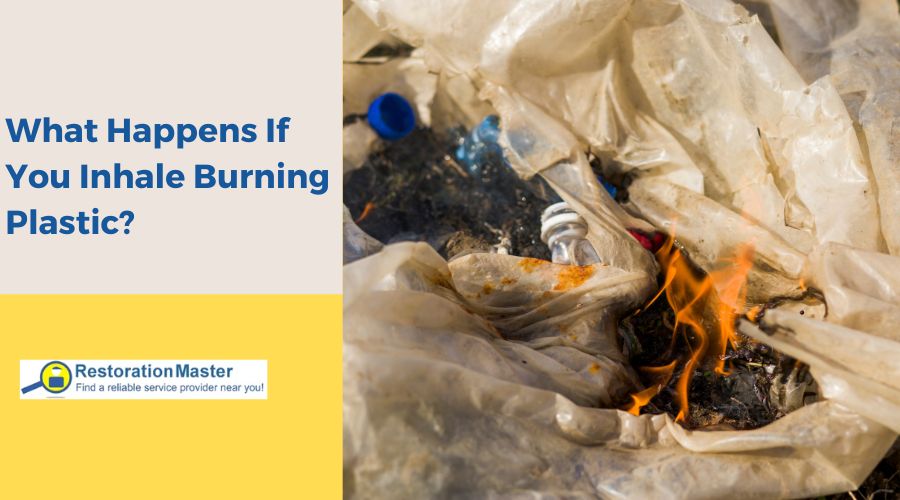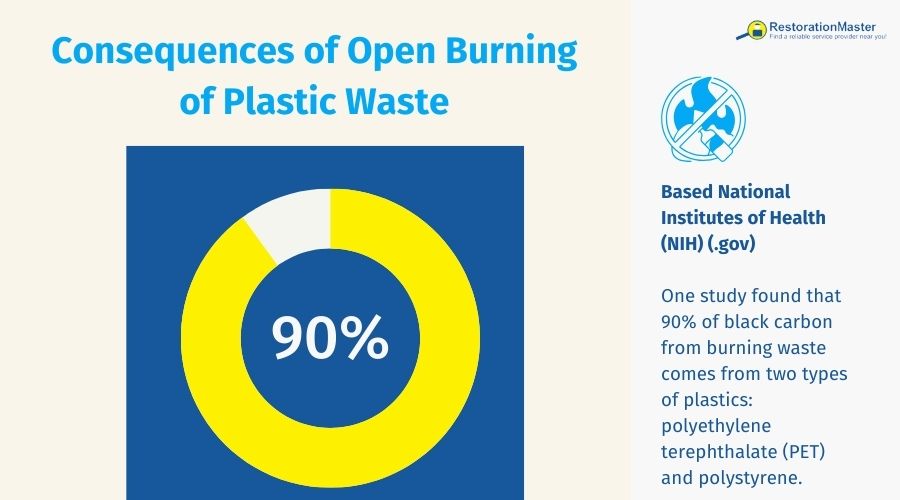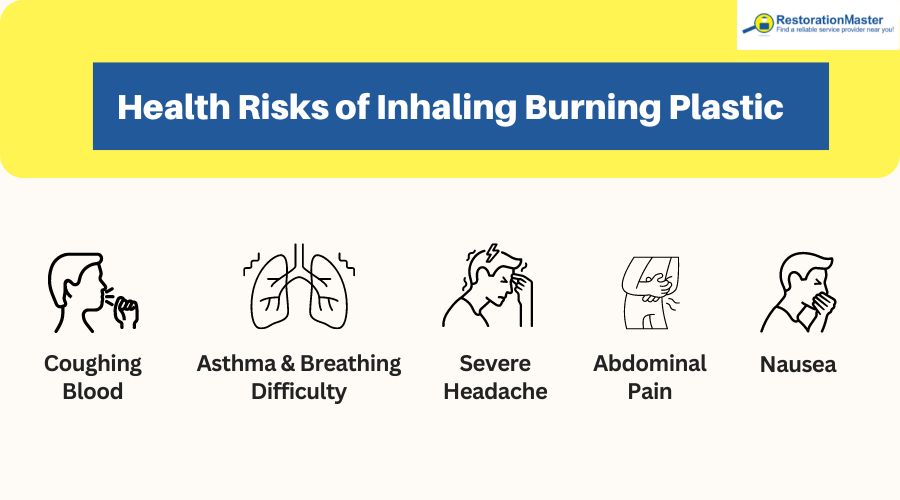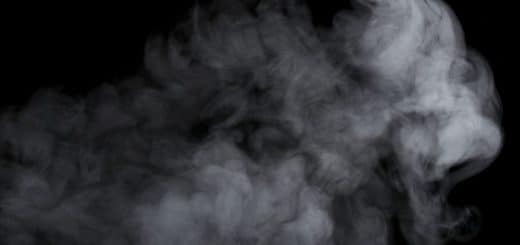What Happens if You Inhale Burning Plastic?
Plastic releases several harmful chemicals including hydrochloric acid, dioxins, furans, and sulfur dioxide when burned. If you ever accidentally come in contact with burning plastic, you may be wondering “what are the potential health consequences?”

Where Does Burning Plastic Occur?
Burning plastic is a scenario most commonly encountered on sites of industrial plants that manufacture, process, and heat plastics. Typically, either heat or pressure is used to moldMold is a type of fungus that grows in damp or humid conditi... More plastics into their desired shapes. The manufacturing equipment used in these processes–injection molding machines, sanders, die heads, etc.–generate high heat and various chemical reactions, thus resulting in the release of plastic fumes.
Outside of manufacturing, other groups of professionals such as firefighters and plastic welders may also encounter burning plastic while on the job due to the process of thermal decomposition. This occurs when compounds break down as a result of heating into their various components, including fatty acids, manufacturing compounds, and plastic fumes.
Types of Plastics
Plastic comes in two main varieties: thermoset and thermoplastic. The former contains permanent chemical bonds and cannot be reshaped or melted back into a liquid state. Thermoplastics, on the other hand, become soft upon heating and eventually turn to a liquid form which allows them to be reshaped.

The following are the most common plastic types:
- PMMA
- Polyurethane
- ABS
- Epoxy
- PS
- PP
- Melamine
- Phenolics
- PVC
- Polyamide
- HDPE
- Polycarbonate
- Polyester
- PETE or PET
- Styrene-Acrylonitrile
- PE
- LDPE
When plastic burns, it emits many toxic gases into the surrounding air, including:
- Acrolein
- Formaldehyde
- Hydrogen Cyanide
- Styrene
- Acetone
- Phenol
- Butadiene
- Aldehydes
- Hydrogen Chloride
- Butane
What Happens When You Inhale Burning Plastic
The health consequences you might face from inhaling burning plastic are dependent on many factors: the type of plastic, the method of burning, the length of exposure to the fumes, etc. However, most commonly, individuals who have been exposed to burning plastic experience throat, nose, and skin irritation. The most adversely affected organs are the lungs. As the lungs swell due to exposure to the fumes, it becomes progressively more difficult for the body to get oxygenOxygen is a chemical element essential for combustion and li... More into the blood, increasing the likelihood of respiratory failure. Other commonly observed adverse effects include asthma, headaches, nervous system damage, heart disease, and damage to vital organs.

With prolonged exposure, individuals may experience the following symptoms:
- Headaches
- Shortness of breath
- Coughing blood
- Aggravated asthma
- Abdominal pain
- Chest pain
- Nausea
Seeking medical treatment quickly is the best way to avoid the long-term consequences of inhaling plastic fumes. For comprehensive relief and thorough removal of any lingering odors, it is advisable to consult professionals who specialize in odor removal.
Burning Plastic in Garages: A Hidden Health Risk
Garages are common places where plastic materials may accidentally catch fire, and many homeowners don’t realize the risks until it’s too late. Old storage bins, containers, insulationInsulation is a material used in buildings to reduce the tra... More, or even parts of your garage door system can become fire hazards under the right conditions. If a garage door opener malfunctions or overheats, it may release smoke from burning plastic components like circuit boards, wires, or casings.
When plastic burns in an enclosed space like a garage, it releases toxic fumes, including dioxins, furans, carbon monoxide, and hydrochloric acid, all of which can pose serious health risks if inhaled. Symptoms can include headaches, nausea, dizziness, respiratory irritation, and in some cases, long-term lung damage or exposure to carcinogens.
Because garages often have limited ventilationVentilation is the process of exchanging or circulating air ... More, the concentration of harmful fumes can build up quickly. If you ever notice a burning plastic smell near your garage door opener, wiring, or stored items, evacuate the area immediately and do not attempt to ventilate or investigate until the source is identified and the space is deemed safe.
How to Prevent Adverse Health Effects From Burning Plastic
While it may not be a life-threatening scenario in every case, inhaling burning plastic is definitely a situation worth taking steps to prevent. Below are several standard best practices you can use to reduce your risk of sustaining health consequences from inhaling plastic fumes.
- Check your air quality levels. Poor air quality can be treated with portable extractors that absorb the fumes using HEPA filters.
- Consider investing in air cleaners to further improve indoor air qualityIndoor air quality (IAQ) refers to the condition of the air ... More.
- Open windows and doors to adequately ventilate your home. Fans can also further improve air circulation when placed near windows and doors.
- To absorb the odorAn odor is a smell, often detectable by the human nose, whic... More of the burning plastic, fill bowls with white vinegar and place them in affected areas of the home.
- Mask the odorAn odor is a smell, often detectable by the human nose, whic... More with deodorizing agents, candles, and incense.
- Treat your carpets overnight with baking soda. Vacuum the following day.
- Use mild dish detergent on walls to get rid of the lingering odorAn odor is a smell, often detectable by the human nose, whic... More.
- Reach out to a fire damage restorationFire damage restoration is the process of repairing and rest... More specialist to clear the area of any lingering smoke, sootSoot is fine black particles composed of carbon and other ma... More, or odors.
- Contact a medical professional immediately if symptoms such as headaches, dizziness, or other conditions do not improve.
The risk of inhaling plastic fumes is highest when working in manufacturing or another industry where plastics are regularly exposed to high heat. However, the risk is always present, even in your own home. Although the chance is minimal that long-term damage will occur, it is important to take steps to prevent inhaling plastic fumes, as doing so can cause extensive damage to your heart, lungs, and other vital organs.

A reputable fire or smoke damage restoration company can assist with cleaning up the aftermath of fires involving burning plastic. In addition to the immediate flames, fires also create smoke, sootSoot is fine black particles composed of carbon and other ma... More, and other corrosive byproducts that can spread further and linger longer on your property than the fire itself. Enlisting the help of a professional restorationRestoration is the process of returning a property to its pr... More team will ensure the property is cleared of burned items and fire byproducts that may contribute to negative health effects.












